Optimising the Cost of Reducing the CO2 Emissions in Sustainable Energy and Climate Action Plans
Abstract
1. Introduction
2. Materials and Methods
- x1 is the level of reduction of CO2 emissions by the implementation of integrated renovation of public buildings;
- k11 and k12—coefficients for the calculation of specific cost gained from regression analysis of integrated renovation of public buildings from other SECAPs, k11 = 16,411.76, k12 = 0.00019845;
- x2 is the level of reduction of CO2 emissions by the implementation of energy renovation of public buildings;
- k21 and k22—coefficients for the calculation of specific cost gained from regression analysis of energy renovation of public buildings from other SECAPs, k21 = 3040.48, k22 = 0.00022593;
- x3 is the level of reduction of CO2 emissions by the implementation of PVs on public buildings;
- k31 and k32—coefficients for the calculation of specific cost gained from regression analysis of PVs on public buildings from other SECAPs, k31 = 6128.25, k32 = 0.0016649;
- x4 is the level of reduction of CO2 emissions by the implementation of solar thermal on public buildings;
- k41 and k42—coefficients for the calculation of specific cost gained from regression analysis of solar thermal on public buildings from other SECAPs, k41 = 11,131, k42 = 0.527;
- x5 is the level of reduction of CO2 emissions by the implementation of electrification of public transport;
- k51 and k52—coefficients for the calculation of specific cost gained from regression analysis of electrification of public transport from other SECAPs, k51 = 107,229, k52 = 0.396;
- x6 is the level of reduction of CO2 emissions by the implementation of integrated renovation of multi-apartment buildings;
- k61, k62 and k63—coefficients for the calculation of specific cost gained from regression analysis of integrated renovation of multi-apartment buildings from other SECAPs, k61 = 0.00023089, k62 = 4.67701, k63 = 29,089.21;
- x7 is the level of reduction of CO2 emissions by the implementation of integrated energy renovation of residential buildings;
- k71 and k72—coefficients for the calculation of specific cost gained from regression analysis of integrated energy renovation of residential buildings from other SECAPs, k71 = 35,236.21, k72 = 0.00007884;
- x8 is the level of reduction of CO2 emissions by the implementation of energy renovation of residential buildings;
- k81 and k82—coefficients for the calculation of specific cost gained from regression analysis of energy renovation of residential buildings from other SECAPs, k81 = 722.1, k82 = 13,030;
- x9 is the level of reduction of CO2 emissions by the implementation of PVs on residential buildings;
- k91 and k92—coefficients for the calculation of specific cost gained from regression analysis of PVs on residential buildings from other SECAPs, k91 = 627.8, k92 = 7772.2;
- x10 is the level of reduction of CO2 emissions by the implementation of energy renovation of commercial buildings;
- k101 and k102—coefficients for the calculation of specific cost gained from regression analysis of energy renovation of commercial buildings from other SECAPs, k101 = 9744.8, k102 = 0.0000328;
- x11 is the level of reduction of CO2 emissions by the implementation of PVs on commercial buildings;
- k111 and k112—coefficients for the calculation of specific cost gained from regression analysis of PVs on commercial buildings from other SECAPs, k111 = 627.8, k112 = 7772.2;
- x12 is the level of reduction of CO2 emissions by the implementation of modernisation of public lighting;
- k121 and k122—coefficients for the calculation of specific cost gained from regression analysis of modernisation of public lighting from other SECAPs, k121 = 17,648, k122 = 0.225;
- x13 is the level of reduction of CO2 emissions by the implementation of infrastructure for electric vehicles and bicycles;
- k131, k132 and k133—coefficients for the calculation of specific cost gained from regression analysis of infrastructure for electric vehicles and bicycles from other SECAPs, k131 = 0.00000896, k132 = 0.4481, k133 = 5796.741;
- x14 is the level of reduction of CO2 emissions by the implementation of purchasing of electric vehicles;
- k141 and k142—coefficients for the calculation of specific cost gained from regression analysis of purchasing of electric vehicles from other SECAPs, k141 = 109,245.1, k142 = 0.3977;
3. Results
3.1. Data on the Case Study
3.2. Measures for the Reduction of CO2 Emissions
- Energy renovation of public buildings (x2);
- PV on public buildings (x3);
- Solar thermal on public buildings (x4);
- Electrification of public transport (x5);
- Energy renovation of residential buildings (x8);
- PV on residential buildings (x9);
- Energy renovation of commercial buildings (x10);
- PV on commercial buildings (x11);
- Modernisation of public lighting (x12);
- Infrastructure for electric vehicles and bicycles (x13);
- Purchasing of electric vehicles (x14).
- Integrated renovation of public buildings (x1);
- Integrated renovation of multi-apartment buildings (x6);
- Integrated energy renovation of residential buildings (x7);
- Electrification of transport (x13 + x14).
3.3. Optimisation of Measures Implementation
4. Discussion and Conclusions
Author Contributions
Funding
Institutional Review Board Statement
Informed Consent Statement
Conflicts of Interest
Appendix A
| Name of the Measure | x Corresponding to the Measure | Coefficients for Calculation of the Measure | SECAPs Used as Data Sources [48] |
|---|---|---|---|
| Integrated renovation of public buildings | x1 | k11 and k12 | City of Rijeka, City of Zadar, City of Osijek, City of Koprivnica, City of Varazdin, City of Cakovec |
| Energy renovation of public buildings | x2 | k21 and k22 | City of Novigrad, City of Porec, City of Pula, City of Rovinj, Municipality of Brtonigla, City of Buje, City of Labin, City of Pazin, Island of Brac |
| PV on public buildings | x3 | k31 and k32 | The city of Rijeka, City of Zadar, City of Osijek, City of Varazdin, City of Novigrad, City of Porec, City of Pula, City of Rovinj, Municipality of Brtonigla, City of Buje, City of Labin, City of Pazin, Island of Brac |
| Solar thermal on public buildings | x4 | k41 and k42 | City of Zadar, City of Osijek, City of Cakovec, City of Novigrad, City of Porec, City of Pula, City of Rovinj, Municipality of Brtonigla, City of Labin, City of Pazin |
| Electrification of public transport | x5 | k51 and k52 | City of Rijeka, City of Zadar, City of Osijek, City of Koprivnica, City of Varazdin |
| Integrated renovation of multi-apartment buildings | x6 | k61, k62 and k63 | City of Rijeka, City of Zadar, City of Koprivnica, City of Varazdin |
| Integrated energy renovation of residential buildings | x7 | k71 and k72 | City of Rijeka, City of Zadar, City of Osijek, City of Koprivnica, City of Varazdin |
| Energy renovation of residential buildings | x8 | k81 and k82 | City of Osijek, City of Varazdin, City of Cakovec, City of Prelog |
| PV on residential buildings | x9 | k91 and k92 | The city of Rijeka, City of Zadar, City of Osijek, City of Varazdin, City of Cakovec, City of Novigrad, City of Porec, City of Pula, City of Rovinj, Municipality of Brtonigla, City of Buje, City of Labin, the City of Pazin, Island of Brac, City of Prelog |
| Energy renovation of commercial buildings | x10 | k101 and k102 | City of Rijeka, City of Zadar, City of Osijek, City of Koprivnica, City of Varazdin |
| PV on commercial buildings | x11 | k111 and k112 | The city of Rijeka, City of Zadar, City of Osijek, City of Varazdin, City of Cakovec, City of Novigrad, City of Porec, City of Pula, City of Rovinj, Municipality of Brtonigla, City of Buje, City of Labin, the City of Pazin, Island of Brac, City of Prelog |
| Modernisation of public lighting | x12 | k121 and k122 | City of Rijeka, City of Zadar, City of Osijek, City of Koprivnica, City of Varazdin, City of Cakovec, City of Porec, City of Pula, City of Buje, City of Labin, City of Pazin, Island of Brac |
| Infrastructure for electric vehicles and bicycles | x13 | k131, k132 and k133 | City of Zadar, City of Osijek, City of Koprivnica, City of Varazdin, City of Cakovec, City of Prelog |
| Purchasing of electric vehicles | x14 | k141 and k142 | City of Rijeka, City of Zadar, City of Osijek, City of Koprivnica, City of Varazdin |
| Additional SECAPs analysed used for measures development | Non-applicable | Non-applicable | The city of Buzet, Island of Korcula, City of Kastva, City of Krizevci, City of Ludbreg, Municipality of Matulji, City of Slatina, City of Velika Gorica, City of Virovitica, City of Zagreb |
References
- Tavella, C.; Spoerndli, C.; Beu, D.; Ceclan, A. CoME EASY—Synchronizing European Energy Award with Other Initiatives. Case Study: Romanian Local Communities. Energies 2021, 14, 6248. [Google Scholar] [CrossRef]
- Feleki, E.; Moussiopoulos, N. Setting emission reduction trajectories in mediterranean cities with the use of science-based targets: The pathway towards climate neutrality and the ambitious european goals by 2050. Atmosphere 2021, 12, 1505. [Google Scholar] [CrossRef]
- Kona, A.; Monforti-Ferrario, F.; Bertoldi, P.; Baldi, M.G.; Kakoulaki, G.; Vetters, N.; Thiel, C.; Melica, G.; Lo Vullo, E.; Sgobbi, A.; et al. Global Covenant of Mayors, a dataset of greenhouse gas emissions for 6200 cities in Europe and the Southern Mediterranean countries. Earth Syst. Sci. Data 2021, 13, 3551–3564. [Google Scholar] [CrossRef]
- Neves, A.R.; Leal, V.; Lourenço, J.C. A methodology for sustainable and inclusive local energy planning. Sustain. Cities Soc. 2015, 17, 110–121. [Google Scholar] [CrossRef]
- Kona, A.; Bertoldi, P.; Kilkiş, Ş. Covenant of mayors: Local energy generation, methodology, policies and good practice examples. Energies 2019, 12, 985. [Google Scholar] [CrossRef]
- Coelho, S.; Russo, M.; Oliveira, R.; Monteiro, A.; Lopes, M.; Borrego, C. Sustainable energy action plans at city level: A Portuguese experience and perception. J. Clean. Prod. 2018, 176, 1223–1230. [Google Scholar] [CrossRef]
- Salvia, M.; Simoes, S.G.; Herrando, M.; Čavar, M.; Cosmi, C.; Pietrapertosa, F.; Gouveia, J.P.; Fueyo, N.; Gómez, A.; Papadopoulou, K.; et al. Improving policy making and strategic planning competencies of public authorities in the energy management of municipal public buildings: The PrioritEE toolbox and its application in five mediterranean areas. Renew. Sustain. Energy Rev. 2021, 135. [Google Scholar] [CrossRef]
- Pasimeni, M.R.; Petrosillo, I.; Aretano, R.; Semeraro, T.; De Marco, A.; Zaccarelli, N.; Zurlini, G. Scales, strategies and actions for effective energy planning: A review. Energy Policy 2014, 65, 165–174. [Google Scholar] [CrossRef]
- Reckien, D.; Salvia, M.; Heidrich, O.; Church, J.M.; Pietrapertosa, F.; De Gregorio-Hurtado, S.; D’Alonzo, V.; Foley, A.; Simoes, S.G.; Krkoška Lorencová, E.; et al. How are cities planning to respond to climate change? Assessment of local climate plans from 885 cities in the EU-28. J. Clean. Prod. 2018, 191, 207–219. [Google Scholar] [CrossRef]
- Salvia, M.; Reckien, D.; Pietrapertosa, F.; Eckersley, P.; Spyridaki, N.A.; Krook-Riekkola, A.; Olazabal, M.; De Gregorio Hurtado, S.; Simoes, S.G.; Geneletti, D.; et al. Will climate mitigation ambitions lead to carbon neutrality? An analysis of the local-level plans of 327 cities in the EU. Renew. Sustain. Energy Rev. 2021, 135. [Google Scholar] [CrossRef]
- Messori, G.; Brocchieri, F.; Morello, E.; Ozgen, S.; Caserini, S. A climate mitigation action index at the local scale: Methodology and case study. J. Environ. Manage. 2020, 260, 110024. [Google Scholar] [CrossRef] [PubMed]
- Hsu, A.; Tan, J.; Ng, Y.M.; Toh, W.; Vanda, R.; Goyal, N. Performance determinants show European cities are delivering on climate mitigation. Nat. Clim. Chang. 2020, 10, 1015–1022. [Google Scholar] [CrossRef]
- Kona, A.; Bertoldi, P.; Monforti-Ferrario, F.; Rivas, S.; Dallemand, J.F. Covenant of mayors signatories leading the way towards 1.5 degree global warming pathway. Sustain. Cities Soc. 2018, 41, 568–575. [Google Scholar] [CrossRef]
- Scorza, F.; Santopietro, L. A systemic perspective for the Sustainable Energy and Climate Action Plan (SECAP). Eur. Plan. Stud. 2021, 1–21. [Google Scholar] [CrossRef]
- Amorim, E.V. Sustainable energy action plans: Project management intercomparison. Procedia Technol. 2014, 16, 1183–1189. [Google Scholar] [CrossRef]
- Nagorny-Koring, N.C.; Nochta, T. Managing urban transitions in theory and practice—The case of the Pioneer Cities and Transition Cities projects. J. Clean. Prod. 2018, 175, 60–69. [Google Scholar] [CrossRef]
- Saad, S.; Lahoud, C.; Brouche, M.; Hmadi, M.; Ghandour, M.; Mourtada, A. Advanced tool for elaborating a sustainable energy and climate action plan at municipalities level. Energy Rep. 2021, 7, 51–69. [Google Scholar] [CrossRef]
- Di Battista, D.; Barchiesi, C.; Di Paolo, L.; Abbate, S.; Sorvillo, S.; Cinocca, A.; Carapellucci, R.; Ciamponi, D.; Cardone, D.; Corroppolo, S.; et al. The reporting of sustainable energy action plans of municipalities: Methodology and results of case studies from the abruzzo region. Energies 2021, 14, 5932. [Google Scholar] [CrossRef]
- McGookin, C.; Ó Gallachóir, B.; Byrne, E. An innovative approach for estimating energy demand and supply to inform local energy transitions. Energy 2021, 229. [Google Scholar] [CrossRef]
- Martire, S.; Mirabella, N.; Sala, S. Widening the perspective in greenhouse gas emissions accounting: The way forward for supporting climate and energy policies at municipal level. J. Clean. Prod. 2018, 176, 842–851. [Google Scholar] [CrossRef]
- Santopietro, L.; Scorza, F. The Italian experience of the covenant of mayors: A territorial evaluation. Sustainability 2021, 13, 1289. [Google Scholar] [CrossRef]
- Pablo-Romero, M.d.P.; Pozo-Barajas, R.; Sánchez-Braza, A. Analyzing the effects of the benchmark local initiatives of Covenant of Mayors signatories. J. Clean. Prod. 2018, 176, 159–174. [Google Scholar] [CrossRef]
- Altamirano-Avila, A.; Martínez, M. Urban sustainability assessment of five Latin American cities by using SDEWES index. J. Clean. Prod. 2021, 287, 125495. [Google Scholar] [CrossRef]
- Jekabsone, A.; Marín, J.P.D.; Martins, S.; Rosa, M.; Kamenders, A. Upgrade from SEAP to SECAP: Experience of 6 European Municipalities. Environ. Clim. Technol. 2021, 25, 254–264. [Google Scholar] [CrossRef]
- Spyridaki, N.A.; Kleanthis, N.; Tzani, D.; Matosović, M.D.; Flamos, A. A city capability assessment framework focusing on planning, financing, and implementing sustainable energy projects. Sustainability 2020, 12, 8447. [Google Scholar] [CrossRef]
- Fiaschi, D.; Bandinelli, R.; Conti, S. A case study for energy issues of public buildings and utilities in a small municipality: Investigation of possible improvements and integration with renewables. Appl. Energy 2012, 97, 101–114. [Google Scholar] [CrossRef]
- Pablo-Romero, M.d.P.; Pozo-Barajas, R.; Sanchez-Braza, A. Understanding local CO2 emissions reduction targets. Renew. Sustain. Energy Rev. 2015, 48, 347–355. [Google Scholar] [CrossRef]
- Dall’O’, G.; Norese, M.F.; Galante, A.; Novello, C. A multi-criteria methodology to support public administration decision making concerning sustainable energy action plans. Energies 2013, 6, 4308–4330. [Google Scholar] [CrossRef]
- Fouché, E.; Brent, A. Explore, design and act for sustainability: A participatory planning approach for local energy sustainability. Sustainability 2020, 12, 862. [Google Scholar] [CrossRef]
- Papapostolou, A.; Karakosta, C.; Kourti, K.A.; Doukas, H.; Psarras, J. Supporting Europe’s energy policy towards a decarbonised energy system: A comparative assessment. Sustainability 2019, 11, 4010. [Google Scholar] [CrossRef]
- Mimica, M.; Dominković, D.F.; Capuder, T.; Krajačić, G. On the value and potential of demand response in the smart island archipelago. Renew. Energy 2021, 176, 153–168. [Google Scholar] [CrossRef]
- Energy Institute Hrvoje Požar. Energy in Croatia Annual Energy Report 2019; Ministry of Economy and Sustainable Development: Zagreb, Croatia, 2021. [Google Scholar]
- Lizačić-Vidaković, M.; Kulić, F.; Vidaković, D.; Šnidaršić, T.; Vidaković, D. Zajednički Akcijski Plan Energetski Održivog Razvitka I Klimatskih Promjena (Joint SECAP) za Područje Grada Dubrovnika, Općine Konavle, Općine Župa dubrovačka, Općine Dubrovačko primorje i Općine Ston; University of Zagreb: Zagreb, Croatia, 2020. [Google Scholar]
- Schenone, C.; Delponte, I. Renewable energy sources in local sustainable energy action PLANs (SEAPs): Analysis and outcomes. Energy Policy 2021, 156, 112475. [Google Scholar] [CrossRef]
- Rivas, S.; Urraca, R.; Bertoldi, P.; Thiel, C. Towards the EU Green Deal: Local key factors to achieve ambitious 2030 climate targets. J. Clean. Prod. 2021, 320, 128878. [Google Scholar] [CrossRef]
- Melica, G.; Bertoldi, P.; Kona, A.; Iancu, A.; Rivas, S.; Zancanella, P. Multilevel governance of sustainable energy policies: The role of regions and provinces to support the participation of small local authorities in the Covenant of Mayors. Sustain. Cities Soc. 2018, 39, 729–739. [Google Scholar] [CrossRef]
- Mutlu, V.; Cindoruk, Y.O.; Cindoruk, S.S. Evaluation of Bursa metropolitan greenhouse Gas inventory and reduction targets. Urban Clim. 2020, 34. [Google Scholar] [CrossRef]
- Palermo, V.; Walsh, C.L.; Dawson, R.J.; Fichera, A.; Inturri, G. Multi-sector mitigation strategies at the neighbourhood scale. J. Clean. Prod. 2018, 187, 893–902. [Google Scholar] [CrossRef]
- Peduzzi, E.; Baldi, M.G.; Pisoni, E.; Kona, A.; Bertoldi, P.; Monforti-Ferrario, F. Impacts of a climate change initiative on air pollutant emissions: Insights from the Covenant of Mayors. Environ. Int. 2020, 145, 106029. [Google Scholar] [CrossRef]
- Palermo, V.; Bertoldi, P.; Apostoulu, M.; Kona, A.; Rivas, S. Assessment of climate change mitigation policies in 315 cities in the Covenant of Mayors initiative. Sustain. Cities Soc. 2020, 60, 102258. [Google Scholar] [CrossRef]
- Buga, N.; Yousif, C. Evaluating drivers and barriers to adopting a local energy policy under The Covenant of Mayors Initiative in the Small Island State of Malta. Energy Policy 2021, 159, 112586. [Google Scholar] [CrossRef]
- Matak, N.; Krajačić, G. Assessment of mitigation measures contribution to CO2 reduction in sustainable energy action plan. Clean Technol. Environ. Policy 2019, 22, 2039–2052. [Google Scholar] [CrossRef]
- Croci, E.; Lucchitta, B.; Molteni, T. Low carbon urban strategies: An investigation of 124 European cities. Urban Clim. 2021, 40, 101022. [Google Scholar] [CrossRef]
- Bernardo, G.; Alessandro, S.D. Societal implications of sustainable energy action plans: From energy modelling to stakeholder learning. J. Environ. Plan. Manag. 2019, 62, 399–423. [Google Scholar] [CrossRef]
- Panuccio, P. Smart planning: From city to territorial system. Sustainability 2019, 11, 7184. [Google Scholar] [CrossRef]
- Prina, M.G.; Cozzini, M.; Garegnani, G.; Manzolini, G.; Moser, D.; Filippi Oberegger, U.; Pernetti, R.; Vaccaro, R.; Sparber, W. Multi-objective optimization algorithm coupled to EnergyPLAN software: The EPLANopt model. Energy 2018, 149, 213–221. [Google Scholar] [CrossRef]
- Manni, M.; Coccia, V.; Paoletti, D.; Raspadori, F.; Ritonummi, T.; Cotana, F. Shaping multi-level energy and climate policy within the set plan framework. Sustainability 2020, 12, 9545. [Google Scholar] [CrossRef]
- Covenant of Mayors. Available online: https://www.covenantofmayors.eu/en/ (accessed on 21 January 2022).
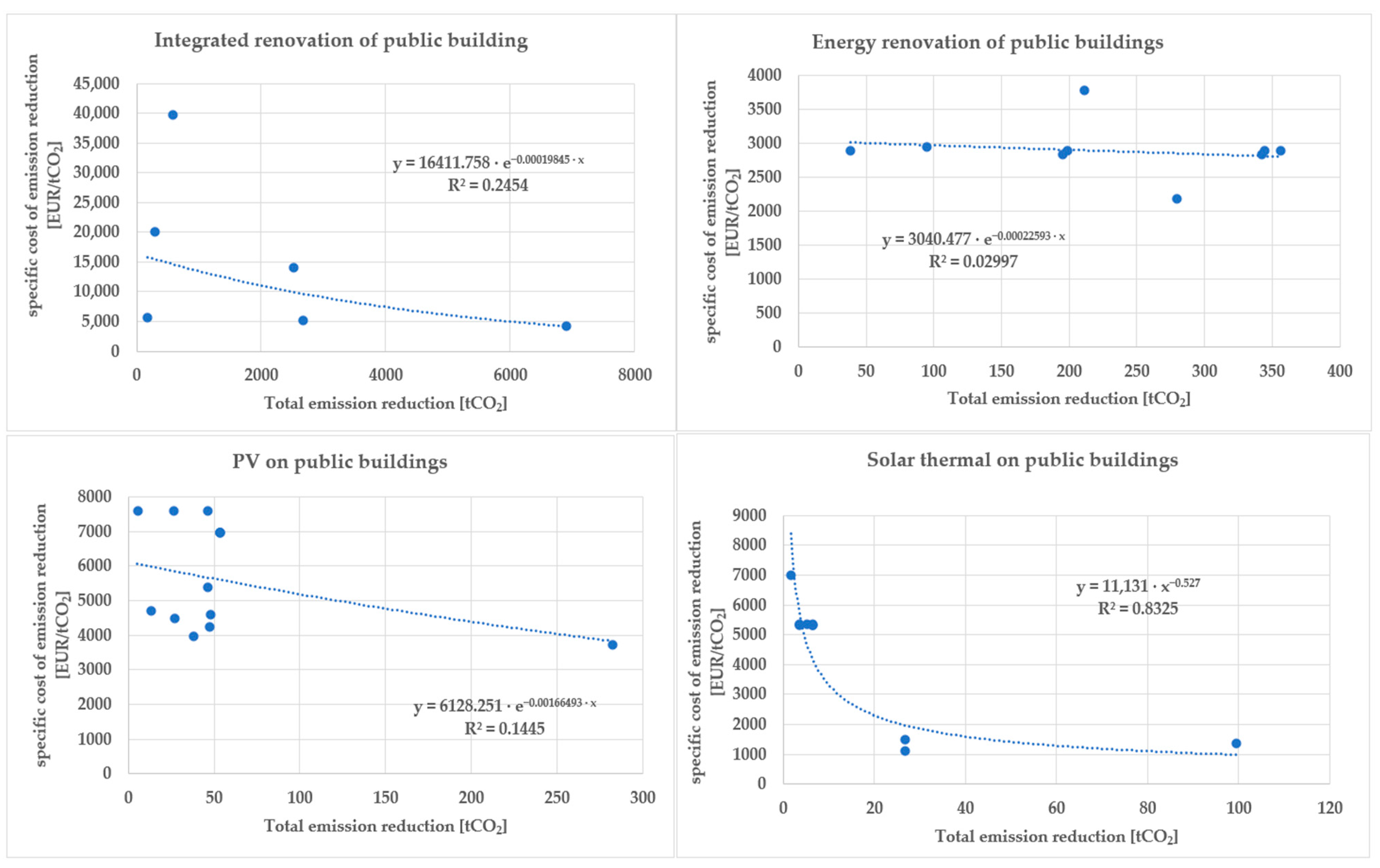
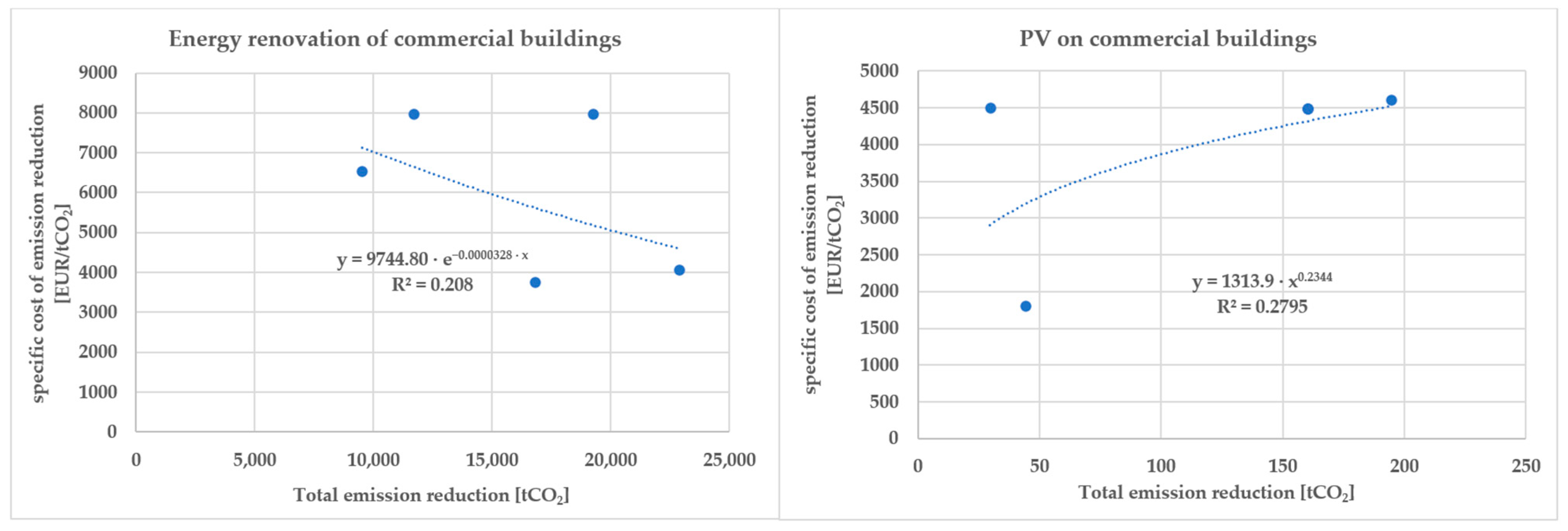



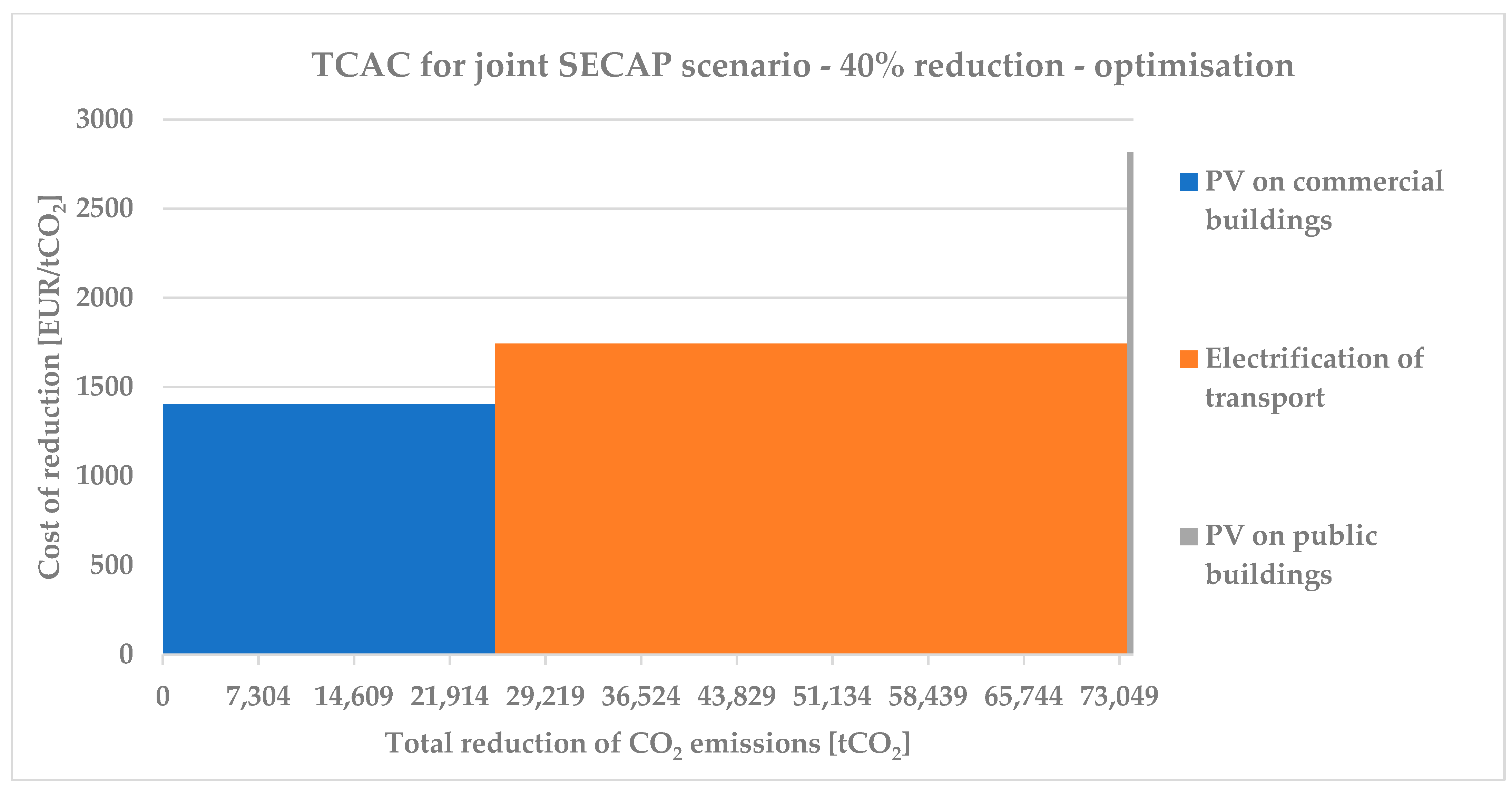
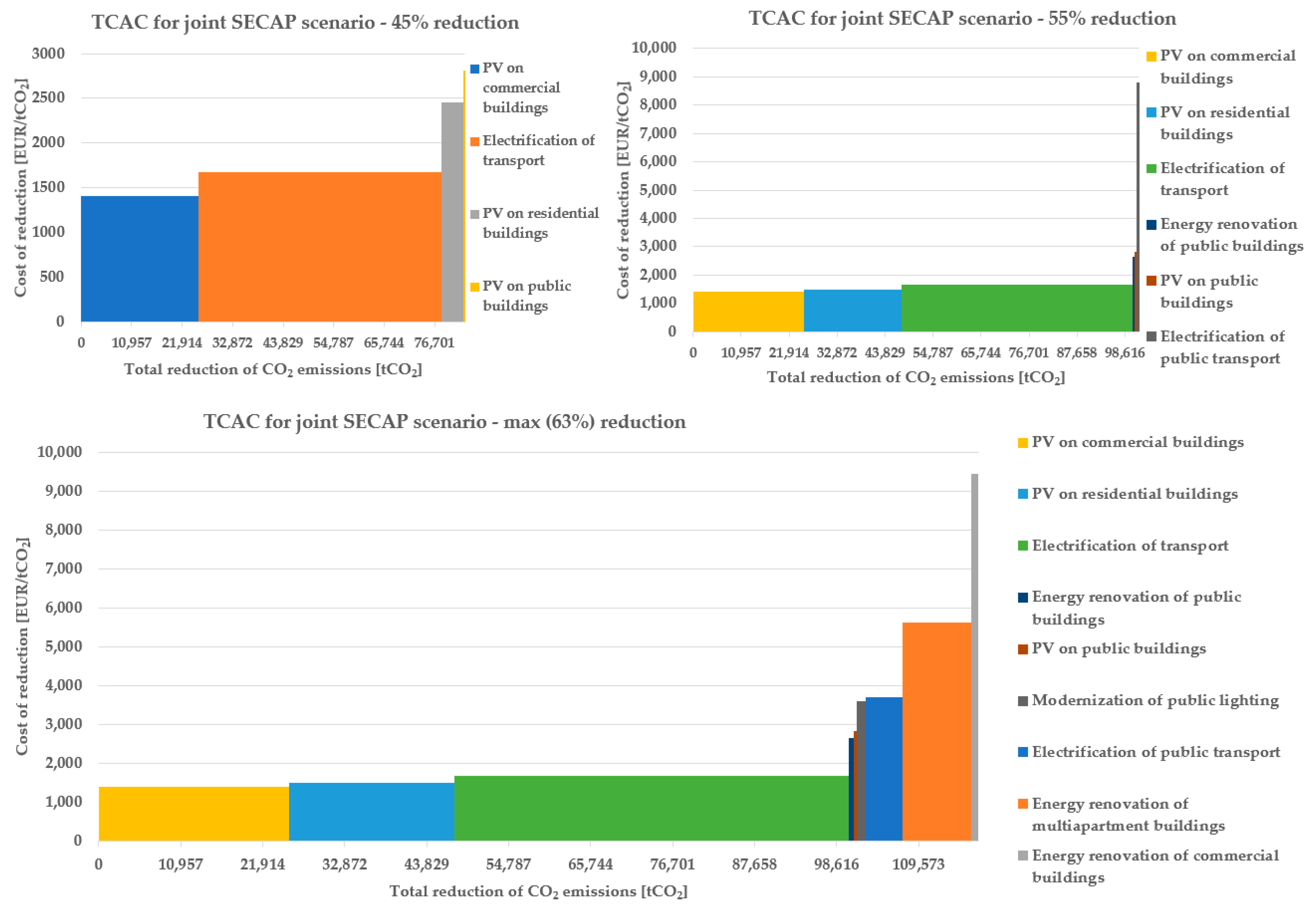
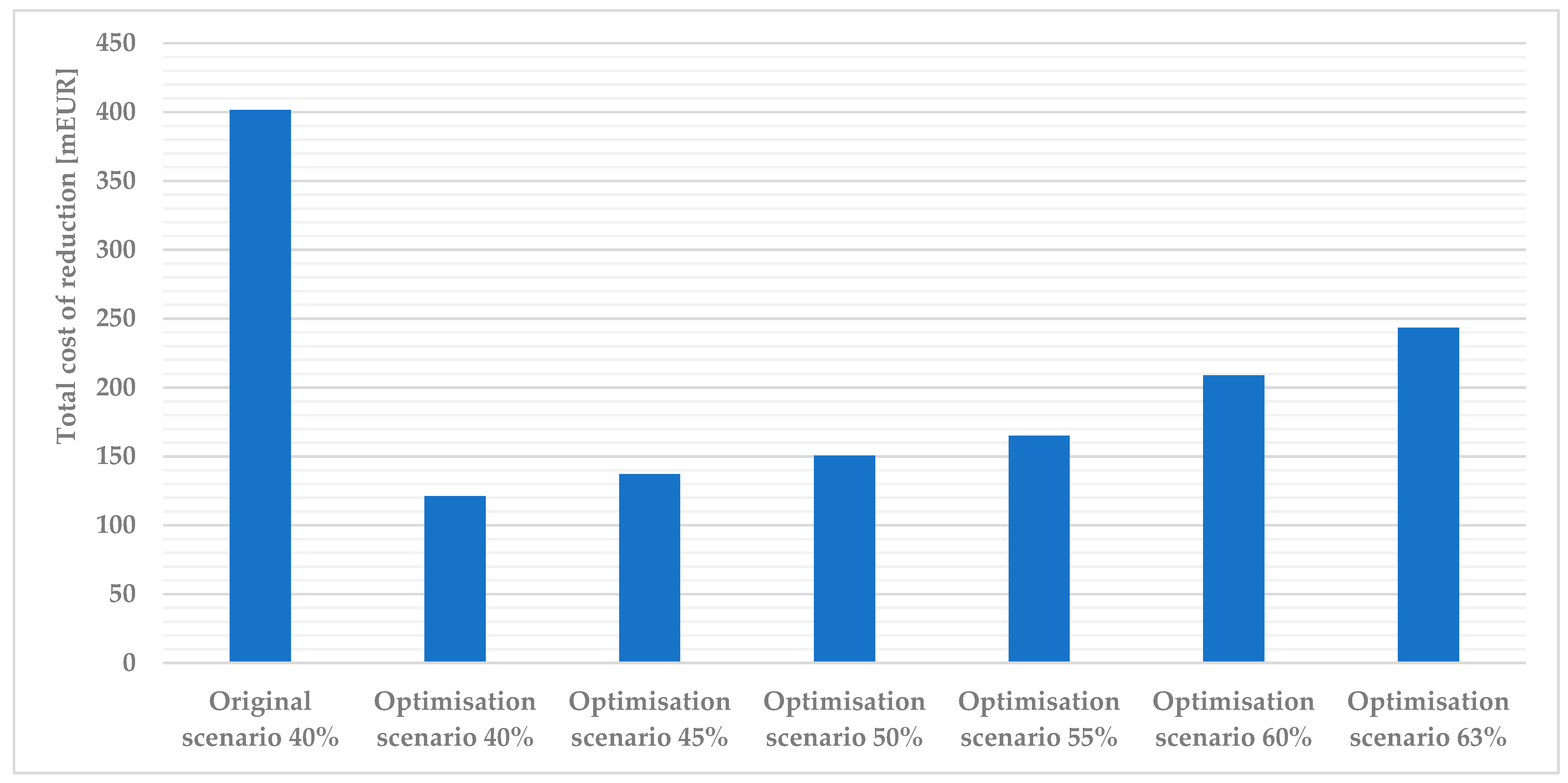
| MWh/Year | Residential Buildings | Commercial Buildings | Transportation | Public Vehicles | Public Buildings | Public Lighting | Public Transportation | Total |
|---|---|---|---|---|---|---|---|---|
| Electricity | 149,276 | 171,617 | 0 | 0 | 3153 | 10,072 | 0 | 334,118 |
| Fuel oil | 26,589 | 19,497 | 0 | 0 | 2310 | 0 | 0 | 48,396 |
| LPG | 17,690 | 6626 | 6427 | 0 | 1198 | 0 | 0 | 31,941 |
| Biomass | 71,707 | 0 | 0 | 0 | 0 | 0 | 0 | 71,707 |
| Diesel | 0 | 0 | 264,904 | 4249 | 0 | 0 | 23,214 | 292,367 |
| Petrol | 0 | 0 | 132,862 | 259 | 0 | 0 | 0 | 133,121 |
| Total | 265,261 | 197,740 | 404,194 | 4508 | 6661 | 10,072 | 23,214 | 911,649 |
| tCO2/Year | Residential Buildings | Commercial Buildings | Transportation | Public Vehicles | Public Buildings | Public Lighting | Public Transportation | Total |
|---|---|---|---|---|---|---|---|---|
| Electricity | 22,093 | 25,399 | 0 | 0 | 467 | 1491 | 0 | 49,449 |
| Fuel oil | 7965 | 5841 | 0 | 0 | 692 | 0 | 0 | 14,498 |
| LPG | 4615 | 1728 | 1677 | 0 | 313 | 0 | 0 | 8333 |
| Biomass | 34 | 0 | 0 | 0 | 0 | 0 | 0 | 34 |
| Diesel | 0 | 0 | 70,729 | 1134 | 0 | 0 | 6198 | 78,062 |
| Petrol | 0 | 0 | 33,083 | 64 | 0 | 0 | 0 | 33,147 |
| Total | 34,707 | 32,969 | 105,489 | 1199 | 1471 | 1491 | 6198 | 183,523 |
| gCO2/kWh | |
|---|---|
| Electricity | 0.1480 |
| Fuel oil | 0.2996 |
| LPG | 0.2609 |
| Biomass | 0.0005 |
| Diesel | 0.2670 |
| Petrol | 0.2490 |
| PV electricity | 0.0000 |
Publisher’s Note: MDPI stays neutral with regard to jurisdictional claims in published maps and institutional affiliations. |
© 2022 by the authors. Licensee MDPI, Basel, Switzerland. This article is an open access article distributed under the terms and conditions of the Creative Commons Attribution (CC BY) license (https://creativecommons.org/licenses/by/4.0/).
Share and Cite
Matak, N.; Mimica, M.; Krajačić, G. Optimising the Cost of Reducing the CO2 Emissions in Sustainable Energy and Climate Action Plans. Sustainability 2022, 14, 3462. https://doi.org/10.3390/su14063462
Matak N, Mimica M, Krajačić G. Optimising the Cost of Reducing the CO2 Emissions in Sustainable Energy and Climate Action Plans. Sustainability. 2022; 14(6):3462. https://doi.org/10.3390/su14063462
Chicago/Turabian StyleMatak, Nikola, Marko Mimica, and Goran Krajačić. 2022. "Optimising the Cost of Reducing the CO2 Emissions in Sustainable Energy and Climate Action Plans" Sustainability 14, no. 6: 3462. https://doi.org/10.3390/su14063462
APA StyleMatak, N., Mimica, M., & Krajačić, G. (2022). Optimising the Cost of Reducing the CO2 Emissions in Sustainable Energy and Climate Action Plans. Sustainability, 14(6), 3462. https://doi.org/10.3390/su14063462





